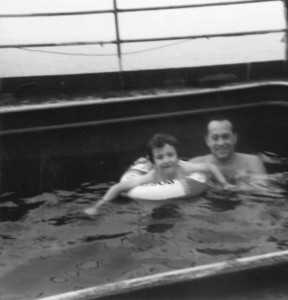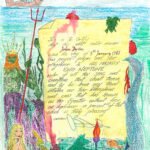Description
HS: The ceremony described in our encounter entitled Mr and Mrs Neptune on the Good Ship Balaena is — as Jonathan Davies (pictured in the rubber ring below) has valiantly pointed out — a relatively common nautical ceremony, which continues to be practiced to this day on merchant and military ships, and even some passenger cruise ships.

After speaking with his father (who was in the Merchant Navy) and researching the phenomenon further himself, Jonathan described the “Crossing-the-Line” ceremony in more detail. As the C&C team are pollywogs – to a man, we hand over this encounter to the learned shellback Jonathan Davies — Don’t worry, all will be revealed!
JD: It is a rite-of-passage ceremony for sailors crossing the equator for the first time, which is traditionally seen as an important step in a mariner’s career. For the purposes of the ceremony, the crew is divided into two groups: those who have never crossed the equator, called “pollywogs” or “tadpoles” (usually modified by the adjective “slimy”) and those who have crossed the equator before, known as “shellbacks” (usually modified by the adjective “trusty”).
The ceremony is performed on the day of the equatorial crossing. The narrative of the ceremony is that King Neptune (usually nowadays played by the ship’s captain) is visiting the ship to put the slimy pollywogs on trial for their “crimes”, to punish them, and then to judge whether or not they are fit to join the Court of King Neptune. Neptune is always accompanied by his “wife” Amphitrite, usually nowadays the first mate in drag, and by his scribe Davy Jones, which is an interesting juxtaposition of classical and post-classical mythological figures! Davy Jones, who dresses like a pirate and carries a comically long scroll, reads out the names of each pollywog in turn, and also lists their crimes, which are usually humorous and bawdy in nature.
 Without fail, King Neptune pronounces all the pollywogs guilty and sentences them to various humiliating ordeals in front of the assembled shellbacks. The humiliations I witnessed on the Nassau Pride involved sailors being made to wear stupid clothes, being pelted with foodstuff and buckets full of brightly-coloured gunk, and being thrown off an upper deck into the swimming pool.
Without fail, King Neptune pronounces all the pollywogs guilty and sentences them to various humiliating ordeals in front of the assembled shellbacks. The humiliations I witnessed on the Nassau Pride involved sailors being made to wear stupid clothes, being pelted with foodstuff and buckets full of brightly-coloured gunk, and being thrown off an upper deck into the swimming pool.
As the Nassau Pride voyage was my first time crossing the equator, I also had to undergo the ritual, but because I was only six they went easy on me: my sentence was just a light pelting with eggs! At the end of all the pageantry and ritual humiliation, the (now ex-) pollywogs are given a certificate, confirming that they have been accepted into the company of King Neptune and are now entitled to be called trusty shellbacks.
My certificate — signed by Neptunus Rex and pictured below — follows the standard wording used by all British merchant navy vessels for the purpose of this ceremony; there are alternatively-worded versions out there, some of which can be seen online. They all have lots of fun classicising touches, like chunks of Latin (note “Imperium Regis Neptuni” along the top!). If you cannot make out the writing on the certificate from the photo, here it is in full:
“This is to certify that this most noble mariner John Davies [sic], upon the day of 5th January 1987, has payed proper and due allegiance to HIS MAJESTY KING NEPTUNE ruler of all the seas and creatures that dwell therein and by his leave may travel between our two hemispheres and cross that line known as the Equator without fear or hindrance in persuit [sic] of that which is truly pleasing.” (signed by the Captain).”
It appears that the earliest attestations are 19th Century – apparently Charles Darwin witnessed the ceremony aboard the Beagle, no less! Some of the other 19th-century accounts quoted from on the Wikipedia page make quite nice companions to the material about the Balaena ceremony.
It is striking that so many details of the ceremony have remained consistent from the time of the Balaena, through the Nassau Pride and into the present day, but there are important differences as well. The drama and pageantry seems if anything to have been more pronounced in the 19th Century: the Balaena account mentions Neptune and Amphitrite climbing over the bow of the ship as if emerging from the deep, and Otto Von Kotzebue, quoted on the Wikipedia page, describes King Neptune being drawn around the deck on a gun-carriage as if on a chariot, which sounds rather grander than the spectacle I remember from my childhood!
But perhaps the most striking change has a class dimension. It seems clear from the Balaena account and other early descriptions that, originally, King Neptune was played by a common sailor. There is something almost Saturnalian about this: the lowly seaman ruling the ship for a day and taking over the captain’s duty of dispensing “justice” to the crew. Nowadays, according to my father, Neptune is almost always played by the ship’s captain, thus the ceremony no longer subverts but instead replicates the power structure of the ship.
HS: One element of the Neptune ceremony that Jonathan could not recall from the dim and distant past was related to him by his mother (pictured above), when she kindly hunted down the photos and expertly coloured in certificate displayed in this encounter:
JD: At the end of it all, the pollywogs had to make offerings to Neptune, the sea and all its creatures. We did this by throwing items of value to us overboard. I threw in some paper flowers, our last Dairy Milk from England, and one of my Transformers action figures.”








